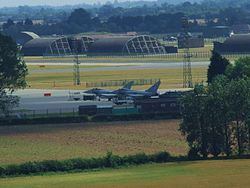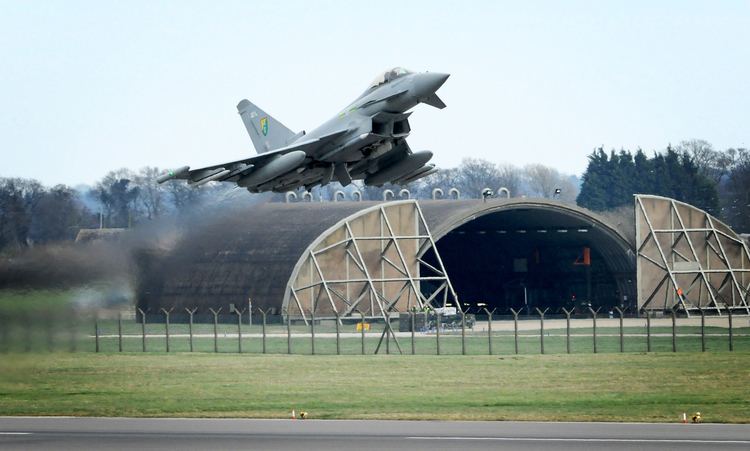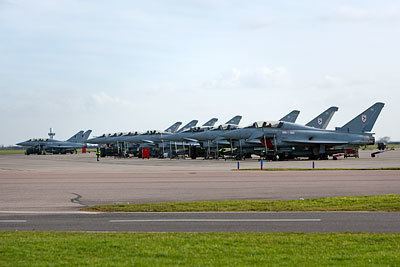Operator Royal Air Force Identifiers IATA: QCY, ICAO: EGXC Elevation 8 m Owner Ministry of Defence | In use 1940–present Code QCY Year built 1940 | |
Type Royal Air Force station Open to
the public Access to BBMF Hangar only Current
commander Group Captain Jez Attridge OBE MSc RAF. Occupants Battle of Britain Memorial Flight, Expeditionary Air Wing, Air Warfare Centre | ||
Raf coningsby a day in the life 10th march 2016 airshowvision
Royal Air Force Coningsby or more simply RAF Coningsby (IATA: QCY, ICAO: EGXC), is a Royal Air Force station located 8.5 miles (13.7 km) south west of Horncastle, and 9.8 miles (15.8 km) north west of Boston, in the East Lindsey district of Lincolnshire, England.
Contents
- Raf coningsby a day in the life 10th march 2016 airshowvision
- Indian air force su 30mki flanker at raf coningsby
- Operational units
- Second World War
- Post war
- Jet aircraft
- Phantoms
- Tornados
- Jaguars
- Eurofighter Typhoon
- Battle of Britain Memorial Flight BBMF
- Operational Evaluation Units
- Current structure
- Station Commanders
- References

The station is commanded by Group Captain Jez Attridge.
Indian air force su 30mki flanker at raf coningsby
Operational units

The station is the home of No. 41 (Test and Evaluation) Squadron—the Operational Evaluational Unit, No. 29(R) Squadron—the Operational Conversion Unit and No. 3(F) Squadron—the first Typhoon Operational Squadron, flying the Eurofighter Typhoon FGR4 and T3. No 11 Squadron joined the station as a Typhoon unit in 2006.

Since June 2007 the Typhoons of No. 3(F) Squadron have formed part of air defence of the UK along with RAF Leuchars near St Andrews, Fife, Scotland, both of which were equipped with Panavia Tornado F3 fighters.
The station is also home to No. 121 Expeditionary Air Wing.
Second World War

RAF Coningsby was opened in 1940 as a bomber station. No. 106 Squadron RAF arrived in February 1941 and No. 97 Squadron arrived in March 1941. Hard runways were laid in early 1943 in preparation for heavy bombers being stationed, part of 5 Group. No. 617 Squadron were at the station from August 1943 – January 1944. Their officers' mess was the Petwood Hotel at Woodhall Spa. 61 Squadron were stationed with Lancasters from February–April 1944. On 12 November, 61 Squadron aircraft equipped with Tallboy bombs sank the Tirpitz in Operation Catechism. 175 aircraft were lost during the war.
Post war

Following the Second World War, it had the Mosquito-equipped 109 Sqn and 139 Sqn, then became part of 3 Group, with Boeing Washington aircraft from 1950. On 17 August 1953 52-year-old Air Vice-Marshal William Brook, the AOC of 3 Group, took off from the base in a Gloster Meteor, and crashed into a Dutch barn at Bradley, Staffordshire.
Jet aircraft

The airfield received its first jet aircraft—the English Electric Canberra—in 1953. During 1956 the station expanded with the runway being extended. Avro Vulcans arrived in 1962, which were transferred to RAF Cottesmore in November 1964.
From 1964–66, the station had been initially designated to receive the proposed RAF fighter, the advanced BAC TSR-2 project, which was cancelled for purported economic reasons in April 1965 by the Labour Government. The TSR2 was planned to join 40 Sqn at Coningsby in 1968 (the squadron had been disbanded with the Canberra at RAF Upwood in 1957). TSR = Tactical Strike Reconnaisance; it was a replacement for the successful Canberra.
Phantoms
The TSR2's intended replacement—the (American) General Dynamics F-111—was shelved on 16 January 1968 when its costs overshot the UK's budget (it would have cost £425m for 50 aircraft). The TSR2 had large development costs, whereas the F-111 (also known as Tactical Fighter Experimental, or TFX) could be bought off the shelf. Coningsby was planned to get the General Dynamics F-111K, the RAF version of the F-111; also in the 1966 Defence White Paper, it was intended that the Anglo-French AFVG, later the UKVG, would replace the TSR2 (it did eventually as the Tornado). 50 F-111Ks were planned with 100 AFVGs (to enter service by 1970); Denis Healey claimed the F-111s and AFVGs would be cheaper than the TSR2 programme (158 aircraft) by £700m. As Minister of Aviation throughout 1965, the Labour MP Roy Jenkins had also wanted to similarly cancel the Olympus-powered Concorde, but the 1962 Anglo-French treaty imposed prohibitive steep financial penalties for cancellation; the Hawker Siddeley P.1154 and HS.681 were cancelled at the same time.
After a parliament debate on 1 May 1967 about the prices of both F-111 and TSR2, Denis Healey simply wanted an aircraft programme that involved no research & development. Healey claimed that, over fifteen years, the TSR2 programme would cost £1,700m and the F-111 and AFVG would cost £1,000m—a large amount in 1965; none of the costings for these two figures were forthcoming, or how both numbers were arrived at, and could well have been fiction. AFVGs were also planned to replace the Buccaneer in the Royal Navy—Tornados were never were flown by the Royal Navy, as the carriers for them, the CVA-01s, were cancelled. But the Royal Navy did operate fourteen Phantoms on Ark Royal, until the new smaller carriers entered service—48 Phantoms had been designated for the Fleet Air Arm, with twenty of these ending up at Leuchars, and Ark Royal's Phantoms ended up at Leuchars in 1978. Eagle was never converted to Phantom use as it was deemed too expensive, and the carrier would simply be scrapped in January 1972, with its Sea Vixen aircraft. Another alternative considered by the Labour government in July 1965 for the TSR-2 was to order Spey-engined French Mirage IV aircraft, to be known as the Mirage IVS; it would have avionics from the TSR-2, and be partly made by BAC at Warton.
Spey-engined Phantoms (the plane the government eventually bought, having been ordered in February 1964 for the Fleet Air Arm, instead of the P.1154) were chosen in 1966 for the station's future as with the scrapping of aircraft carriers the Phantoms were not needed for the Fleet Air Arm, with all RAF Phantom training taking place on the airfield, and the station became part in Fighter Command until December 1967, when it joined Air Support Command as the Phantoms were initially in a ground attack role. Phantoms first saw operational service with the Fleet Air Arm in 1970. The first Phantom FGR2 (Fighter/Ground attack/Reconnaissance) arrived at Coningsby on 23 August 1968, with the first aircrew OCU course (228 OCU) beginning in October 1968. Air-defence Phantoms (FG1) also entered service in 1969 at RAF Leuchars. On 18 May 1970, a Phantom flew from the base non-stop to RAF Tengah, covering 8,680 mi (13,970 km) in 14 hours and 14 minutes at an average speed of 602 mph (969 km/h). In April 1968, Strike Command was formed and the airfield was transferred to 38 Group.
41 Sqn joined in April 1972, and stayed until 1977. The other ground attack Phantom squadrons (four of them) were at RAF Bruggen. 111 Sqn replaced their Lightnings (from Wattisham) with Phantoms from 1 October 1974. On 1 January 1975, 29 Sqn joined and stayed until 1987, when disbanded. On 1 November 1975, 23 Sqn joined until February 1976, when moved to Wattisham. In March 1976, 56 Sqn joined until July 1976, then went to Wattisham.
The Phantom's role changed to air defence in October 1974 when the airfield transferred to 11 Group in RAF Strike Command, when the SEPECAT Jaguar (situated in Norfolk) took over the ground attack role. 111 Sqn were the first to take the new air defence Phantoms. During 1975, the UK's air defence transferred to the Phantom FGR.2 from five squadrons of Lightnings. The UK was covered by NATO Early Warning Area 12. Three Sector Operations Centres were at Buchan, Boulmer and Neatishead; in the 1960s, the UK had the Linesman/Mediator radar system, which was obsolete by the 1970s. No 29 Sqn formed with Phantoms at Coningsby on 1 January 1975; until then the Phantom FG.1 had been operating with the Royal Navy only. On 3 March 1975 a Phantom crashed into a nearby house, with both pilot and navigator ejecting. The Queen visited the station on 30 June 1976. Part of 228 OCU, 64 Sqn trained the navigators and instructors at the base; hardened aircraft shelters were built in 1981.
Tornados
The Tornado F3 squadrons began to form; 229 OCU (65 Sqn) trained on the Tornado from November 1984. Tornado training took place until April 1987, when the Phantoms left (to RAF Leuchars) and Coningsby had the first (29 Sqn) Tornado air defence squadron. To accommodate these new aircraft, extensive hardened aircraft shelters (HAS) and support facilities were built. 5 Squadron arrived in January 1988; 5 Sqn had previously been on the Lightning. The Tornado ADV carried the GEC-Marconi AI.24 Foxhunter radar.
During the Gulf War, Tornados from Coningsby were based for three months at Dhahran International Airport. Tornado engines were serviced on the northern section of the former RAF Woodhall Spa, denoted as RAF Woodhall.
Jaguars
6 Sqn flew the last of the RAF's Jaguar aircraft at Coningsby briefly from April 2006 to May 2007; it was stood down from RAF service on 30 April 2007.
Eurofighter Typhoon
Coningsby was the first airfield to receive the Phantoms, the Tornado ADV and was the first to receive its replacement, the Eurofighter Typhoon. 56 Squadron was posted here until March 2003 but relocated to RAF Leuchars and in 2008 to RAF Waddington to allow airfield improvements required for the arrival of the Typhoon. 5 Squadron also flew F3s from Coningsby until its disbandment in 2003 (this unit is now at Waddington). Typhoon arrived in May 2005 with No. 17 Squadron, after the RAF first publicly displayed the aircraft at Coningsby in December 2004. In July 2007, the Typhoon became operational from the airfield (and the UK). The Typhoon also became operational from RAF Leuchars in September 2010. BAE Systems Military Air Solutions, who produce the aircraft, are also stationed on the airfield with the contract to maintain the aircraft. On 1 July 2008, the Typhoon was declared by the RAF as being combat ready. The aeroplane, unlike the Tornado, needs no reheat to take off. RAF Coningsby is currently home to four front-line Eurofighter Typhoon squadrons. No. 3 Squadron, No. XI Squadron, No. 29 Squadron and No.41 (R) Squadron are posted to RAF Coningsby.
Battle of Britain Memorial Flight (BBMF)
Coningsby is also the home to the Battle of Britain Memorial Flight (since March 1976 when it arrived from RAF Coltishall) and their Visitor Centre. The BBMF operate one of two remaining airworthy Avro Lancaster bombers in the world besides six Spitfires of various types, two Hurricanes, a Dakota and two Chipmunks, the latter type being used for pilot training.
The BBMF is accessed via a separate side entrance, with a car park, to the west of the airfield. The memorabilia display is free but there is a small charge for the hour-long guided tour around the hangar.
Operational Evaluation Units
Also located at Coningsby is the RAF's Fast Jet and Weapons Operational Evaluation Unit (FJWOEU), a merger of the Strike/Attack OEU (previously at Boscombe Down), the Tornado F.3 OEU (previously at RAF Waddington) and the Air-Guided Weapons OEU (previously at RAF Valley). Today, the unit operates under the shadow squadron numberplate of No.41(Test and Evaluation) Sqn since 1 April 2006 and, as part of the Air Warfare Centre, is tasked with operational testing and evaluation of existing and forthcoming aircraft and weapons.
No. 121 Expeditionary Air Wing was formed at Coningsby on 1 April 2006 and encompasses most of the non-formed unit personnel. The EAW does not include any of the flying squadrons. The Station Commander is triple-hatted as the Commanding Officer of the Wing and as Typhoon Force Commander.
Current structure
The RAF Coningsby structure as of October 2010:
Station Commanders
1974 Norfolk mid-air collision: On 9 August 1974, the station commander 42-year-old Group Captain David Blucke, and his navigator Flight Lieutenant Terence Kirkland (aged 28 and from Londonderry), were killed whilst piloting the Phantom XV493 of 41 Sqn. At low-level it hit a Piper Pawnee crop-spraying plane (from Southend-on-Sea) over Fordham, Norfolk, near Downham Market. Blucke was son of Air Vice-Marshal Robert Blucke who was known for the 1935 Daventry Experiment.
The following Station Commanders are listed in the rank held at the time of appointment:
